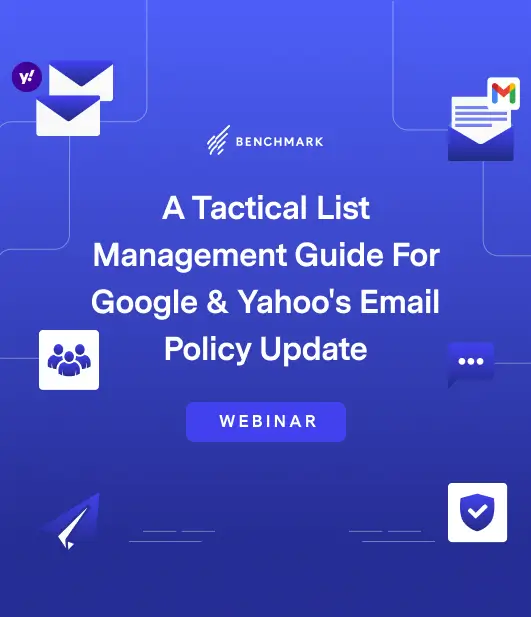
No one wants to end up on the email blacklist.
If you’re struggling to reach people with your emails, there’s a small (but not insignificant) chance that you’ve somehow found your way onto a spam blacklist. These prevent your emails from ending up in your subscribers’ inboxes, which, as you might expect, is going to have a majorly negative impact on your ability to succeed with email marketing.
There are hundreds of spam blacklists, and unfortunately, they sometimes catch the good guys along with the bad. So how do you know if you’ve been blacklisted? We’ve put together this quick dive into blacklists for email marketers, including how to check if you’ve been blacklisted and what to do if you have.
What is Blacklisting, and Why is it Bad?
An email blacklist is a tool that servers use to decide which emails should be considered spam and which shouldn’t. You have blacklists to thank for why you’re not constantly clearing out fake promos and financial “opportunities” from foreign princes in your inbox. They’re also why you might be struggling to reach your audience.
Essentially, each blacklist serves as a filter that helps servers trap spam and keep it in the junk folder where it belongs, with various ways of parceling out the spam from the other emails being sent. This is why you might know blacklisting by its other common name: spam trapping.
For the most part, blacklists do an excellent job at their intended purpose. But the ways that they decide what’s spam and what’s not means that sometimes well-meaning email marketers can also end up getting (in)boxed out. When this happens, it’s usually due to one of three different specific traps that a marketer has fallen into:
-
- Typo traps. If there are lots of typos in the email addresses in your contact list (for example: name@gmial.com instead of name@gmail.com), spam traps are likely to assume that your list and your intentions aren’t so great. A few contact typos shouldn’t harm you, but it does become a concern if it’s happening in excess.
- Pristine traps. Another way blacklists trap unsuspecting spammers is by spreading email addresses and domains that don’t actually exist, with the understanding that if someone starts mailing those addresses, it’s because they bought or scraped them — both of which are common among spam accounts.
- Recycled spam traps. Beware of emailing dormant contacts. Email addresses that constantly bounce back are flagged as spam trap addresses, which could end up harming you if you’re not paying attention.
- Using spam trigger words. In email marketing, there are certain words that, when used, will be marked as spam. Overall, they’re mostly promotional by nature or associated with shady requests and promises. So, beware of the copy you use when putting your emails together.
Another way to end up getting blacklisted is for a lot of your contacts to flag you as spam. This shouldn’t be a concern, though, if you’re practicing proper list etiquette, like maintaining an opt-in-only email list , email verification software and providing a clear place for people to unsubscribe.

Email Deliverability 101: Understanding the Basics of Making it to the Inbox
DOWNLOAD NOWHow to Check if You’re Blacklisted
Worried that you might have accidentally gotten yourself on a blacklist?
Because there are more than a hundred blacklists out there, your best bet is to use an aggregate service like MXToolBox to find out if your email address has made its way onto the dark side. Other helpful tools that you might want to try include the Barracuda Reputation Block List, MultiRBL, and Sender Score.
If you’ve somehow found your way onto a blacklist, you’re not totally out of luck. Send the blacklist operator a request asking for your IP address to be removed, and try not to be too defensive, even if you don’t know how you ended up there. Some operators may remove you right away, while others will first ask you to do a few things, such as sending a re-permission request to all of your contacts.
If your domain name or IP Address is blacklisted at any ISP, you need to send them a request to be removed from their blacklist (de-listed).
Here are the basic steps that you should follow for the whitelisting/de-listing procedure at the ISP in question:
- You should follow the URL links & apply for whitelisting/de-listing using their online form. And/or:
- You should send an email to the mentioned email address.
Here are Some Common ISPs:
- Comcast:
- Follow this URL: www.comcastsupport.com/rbl
- Fill out the online form & submit.
- EarthLink:
- Send an email to: blockedbyearthlink@abuse.earthlink.net
- Use the subject line <Blocked ‘insert your email server’s IP’> (example: Blocked 255.255.255.2555)
- More details are given on these pages:
- Gmail:
- Read Gmail’s Bulk Senders Guidelines here: https://www.google.com/mail/help/bulk_mail.html
- Then follow this URL for the Bulk Sender Contact Form: https://mail.google.com/support/bin/request.py?contact_type=bulk_send&hl=en
- Fill out & submit.
- Hotmail:
- Follow this URL: https://support.msn.com/eform.aspx?productKey=edfsmsbl&ct=eformts
- Click “Contact Us.”
- Verizon:
- Follow this URL: https://forums.verizon.com/t5/Verizon-net-Email/Blocked-IP-Address-Whitelist-Request/td-p/820064
- Fill out the online form & submit.
- Yahoo:
- If you have been blacklisted, visit Yahoo Postmaster
- Click “Problems Delivering Email”
- Mail.ru:
- Follow this URL for the Google page translator tool: https://translate.google.com
- Check “Translate from Russian” and “Translate to English”
- Enter this link in the form: mail.ru/notspam/ Then and hit Enter or Return.
- Read and follow the directions on the newly translated page.
- AOL.com:
- If you have been blacklisted, visit AOL Postmaster
- Click “Problems Delivering Email”
Blacklist Lists [RBL/DNSBL]:
- Lashback:
- Follow this URL to find whether your IP is blacklisted: https://blacklist.lashback.com/
- Input your IP address to request to be delisted.
- BarracudaCentral:
- Follow this URL to find whether your IP is blacklisted: https://www.barracudacentral.org/lookups
- Then follow this URL: https://www.barracudacentral.org/rbl/removal-request Fill out the online form & submit
- Spamhaus:
- Follow this URL to find whether your IP is blacklisted: https://www.spamhaus.org/lookup.lasso
- Fill out the online form, submit and follow appropriate links.
- Invaluement.com:
- Follow this URL to find whether your IP is blacklisted: https://dnsbl.invaluement.com/lookup/
- Fill out the online form & submit.
- Uribl:
- Follow this URL to find whether your IP is blacklisted: https://lookup.uribl.com/
- Hostkarma blacklist:
- https://ipadmin.junkemailfilter.com/remove.php
- Fill out the online form & submit.
- Spamcop:
- For network and server administers: https://www.spamcop.net/fom-serve/cache/298.html
- For bounce message recipients and end-users: https://www.spamcop.net/fom-serve/cache/405.html
- Blacklist IP look-up: https://www.spamcop.net/bl.shtml
How to Avoid Getting Blacklisted
It’s much easier to stay off of blacklists than to get your address removed once it’s been flagged. Aside from making sure that you don’t fall into spam traps, here are a few other ways to prevent your IP from being blacklisted:
-
- Maintain an opt-in list. Never email someone without their permission. An opt-in list may take more time to grow, but it’s much higher quality — and much less likely to get flagged.
- Remove addresses that bounce. If you get a notice that an email has bounced and/or otherwise been noted as undeliverable, remove it from your list. The more you message these types of addresses, the more likely it becomes that you’ll get blacklisted.
- Check your contact list for typos. Set aside some time to scroll through your contact list and make sure that everything is input correctly. It could take a while, but it’s worth it for assurance that you’re not sending out dud messages.
- Perform routine maintenance. Prune your email list regularly to ensure no spam accounts, bounced emails, or incorrect emails have made it on there.
- Don’t buy emails. At Benchmark Email, we always preach the importance of building your email list over buying it. When you focus on building it, you use tactics that are safer and yield quality. When you buy, you don’t really know what you’re getting. Oh, also, it’s a violation of GDPR guidelines.
- Verify email addresses. Marc Schenker from The Glorious Company, a copywriting and content marketing agency, uses email verification tools to ensure the emails they’re sending to are legit. Tools he uses include ZeroBounce and Kickbox.

Maximizing Deliverability: A Tactical List Management Guide for Google & Yahoo’s Email Policy Update
DOWNLOAD NOWWant to take the guesswork out of staying off of blacklists? Use an email marketing automation tool, like Benchmark Email. Our software integrates with various deliverability tools, which can help you ensure your lists stay clean, your emails make it to the inbox, and overall, you’re doing all you can to avoid getting blacklisted.






